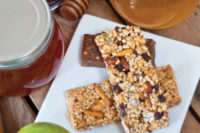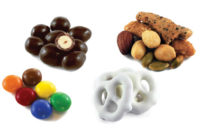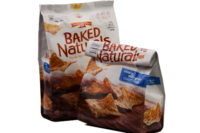New Year’s Day used to be a day when people resolved to exercise regularly, break bad habits and eat better. By the time Valentine’s Day—or Super Bowl Sunday—rolled around, those proclamations became distance memories, especially when it came to eating better. Who could resist devouring a large slice of red velvet cake or diving into a bowl of cheese-covered nachos?
But thanks to the media and proactive food retailers and manufacturers, Americans today are discovering that it’s easier than ever to eat healthier anytime and anywhere. They’re also more educated about the foods they eat and read more labels. Likewise, demanding manufacturers are using more nutritious ingredients in their products. To help bakers and snack producers create healthier products for consumers, ingredient manufacturers are doing the same for their customers.
Protein power
Zurich-based Barry Callebaut, a supplier of high-quality chocolate and cocoa products, is constantly researching and creating new inclusions for baking and snack bar manufacturers, says Laura Bergan, senior marketing manager. To address the current Greek yogurt trend, the company developed a new line of Greek yogurt coatings and inclusions. The coatings are appropriate for enrobing or drizzling cookies, baked goods or snack bars. The confectionery chips can be applied in cookies, snack and energy bars and baked goods.
“Our Greek yogurt products contain more protein than a standard yogurt coating,” Bergan says. “So in addition to a unique flavor profile, these chips offer higher protein levels.” And more consumers interested in improving their diets are seeking out foods with higher protein levels.
QualiTech Inc., Chaska, Minn., also offers inclusions and particulates that enable bakers and snack manufacturers to increase their products’ protein levels. “QualiTech recently developed new inclusions and particulates that enable the delivery of protein sources at levels exceeding 30% within the bit,” says Denise Radke, marketing manager.
Not only do protein inclusions mean better-for-you products for consumers, they can offer bakers and snack manufacturers cost savings and production benefits. “These protein inclusions can be formulated for a variety of cost points, depending on the protein source chosen,” says Radke. “Providing protein within inclusions can help avoid problems with browning or discoloration in baked goods, dough bake volume issues and potential bitter or off-flavor notes.”
The company also introduced several new flavors in the past year, in response to consumer trends: Savory flavors, such as natural-flavor bacon, sausage, chili pepper, pizza and French toast; sweet-and-savory offerings, such as caramel sea salt, mango-habanero and honey chipotle; and sweet flavors, like orange Dreamsicle, birthday cake, vanilla icing, honey, jumble berry and Clementine. Other introductions are streusel-type toppings for bakery and snack products, available in a variety of fruit and vegetable flavors and colors, and particulates with exotic fruit flavors like tart cherry, acai, pomegranate and mango.
“One key area that we’re currently working on is restructured fruit,” says Radke. “Using fruits offers several challenges: Sourcing, supply, seasonality [and other factors] that drive cost. Also, available fruit sources don’t always deliver the eating qualities that consumers expect. We are working on inclusions that not only offer fruit content, but are also designed to deliver the eating qualities associated with fruit.”
QualiTech’s inclusions and particulates can be used to add more fiber, protein and fruit content; reduce sugar or fat; or improve taste, color or texture. They may also enable bakers and snack producer to make claims that their products are organic, all-natural, trans-fat-free, gluten-free, whole-grain, nongenetically modified and more.
The real deal
Bakers and snack manufacturers committed to using real fruit in their formulations will find two staples—tart cherries and blueberries—plentiful and affordable this year.
“The 2013 tart cherry crop was above normal, and we are in a strong supply position for bakers and snack producers,” says Jeff Manning, chief marketing officer, The Cherry Marketing Institute, Lansing, Mich. “Prices are set by individual processors and marketers, but should be below last year.”
That’s good news for food companies making or developing products with tart cherries—scones, muffins, breads, bars and pies—is that consumers want them. “Tart is on-trend, which gives tart cherries an edge to meeting the growing demand for sour flavors,” Manning says. “Expert trend trackers are even saying that sour is the new spicy, and that consumer taste preferences are moving away from sweet, which has contributed to America’s new-found desire for tartness.”
Consumers are also more aware of numerous health benefits of tart cherries. “Tart cherry consumption has been linked to a number of cardiovascular benefits, from overall anti-inflammation to reductions in cholesterol levels to decreased risk for atherosclerosis and metabolic syndrome,” Manning explains. Research shows that tart cherries may help athletes reduce muscle damage, may reduce the risk of gout attacks and can help reduce insomnia and increase overall sleep efficiency.
Tart cherries’ year-round availability and numerous forms—dried, frozen, juice and concentrate—make these red orbs a versatile ingredient for both professional and home bakers. Dried cherries and cherry juice concentrate are the fastest growing categories for the industry, according to The Cherry Marketing Institute.
Little blue dynamos
Like tart cherries, blueberries are available year-round in many formats, including frozen and individually quick frozen (IQF), dried, liquid, canned, concentrate, osmotically preserved, freeze-dried and dehydrated powder. Their uses are also seemingly limitless. They can be used in baked goods, granola bars, granola and trail mixes, grain-based products, mixes, dairy products, sauces, jerky, fillings, stuffing and more.
In addition, the popularity of fruit such as blueberries has led the food industry to create new ways to eat traditional fruit to provide flavorful, healthy snacks, according to the U.S. Highbush Blueberry Council (USHBC), Folsom, Calif. Fruit pouches, bite-sized pieces, formed shapes, bars or logs and fruit spreads in stay-fresh plastic tubs are just some of the innovations making it easy for consumers to enjoy blueberries.
Consumer perception of blueberries as healthy ingredients has contributed to a surge in the popularity and sales of all blueberries forms, says the USHBC. Blueberries contain a number of substances thought to have health benefits, including dietary fiber, vitamins, minerals, antioxidants, phenolics and flavonoids. They also are low in fat, sodium carbohydrates and cholesterol, and can be used to reduce the use of sugar, high fructose corn syrup and other sweeteners in baked goods and snacks.
As consumer demand for these “little blue dynamos” continues to grow this year, bakers, snack producers and other food processors should be able to find adequate supplies at affordable prices, thanks to a reportedly large U.S. blueberry crop last year. It follows 559.4 million lb. of blueberries in 2012 and 532.9 million lb in 2011, according to the USHBC’s April 2013 North American Highbush Blueberry Market Situation report.
Nuts for almonds
Almonds, another popular bakery and snack ingredient, may be impacted this year by California’s prolonged drought. “As of November 2013, shipments exceeded the prior year by nearly 8%,” says Bill Morecraft, general manager, Blue Diamond Almonds Global Ingredients Division, Sacramento, Calif. “January is when the traditional pre-bloom risk assessment on the next crop year begins. This new crop will be impacted by the concern for California’s ongoing drought, so while the demand for almonds remains strong, the availability is tight. As we progress into bloom, prices are expected to stay firm.”
Meanwhile, the Almond Board of California, Modesto, Calif., says that this year’s objective crop estimate for California almonds is 1.85 billion lb., the third largest crop in history, but 2% less than last year’s record-breaking crop.
Despite potentially tight supplies and firm prices, bakers and snack manufacturers will continue using various almond forms—whole, diced, slivered, butter, paste, oil, flour—in products. “Almonds are a tried-and-true ingredient in a variety of baked goods and snacks, from granola bars and trail mix to muffins and crisps,” Morecraft says. “With regard to snack bars, research suggests a growing market. According to a report from Rabobank’s [Food & Agribusiness Research and Advisory Group, “Never Eat More Than You Can Lift,” the market for snack bars has more than doubled over the last 10 years. Almonds make the ideal addition to these products because they offer nutritious benefits such as protein, fiber, vitamin E, calcium and other minerals, and contribute to satiety, helping consumers feel full longer.”
In fact, 1-oz. of whole almonds contains 6 g. of protein and 4 g. of fiber, says Molly Spence, regional director, North America, for the Almond Board, making them “a powerful choice for incorporating texture and new flavors.”
Gluten-free gains
Almond flour also continues to gain traction due to demand for gluten-free products, says Spence, adding that almonds are gluten-free in all forms. “According to the Almond Board of California’s resident culinary expert research chef, John Csukor, with the ever-growing popularity of gluten-free products, almonds can be a developer’s best friend and strongest tool,” Spence explains. “Due to a lack of stickiness from gluten in nongluten dough, many developers will instead create a batter. A key attribute of almond flour is its ability to maintain hydration during baking, making it an ideal and practical inclusion in wide-ranging baking batters.”
In addition to fulfilling consumer demands for portable, satisfying, nutritious and gluten-free snacks, almonds are also addressing consumer interest in nontraditional flavors.
“The Blue Diamond R&D teams working in our Almond Innovation Center develop new flavors to meet our customers’ individual goals,” Morecraft explains. “Some recent flavors we have been working with include orange, honey and coconut.”
Spence adds, “We’re seeing more roasted almonds than we have traditionally, as consumers want more deep, toasty flavor and crunch from their almonds.”
Adaptable almonds
Almonds offer bakers and snack manufacturers as many benefits as they do consumers. In addition to being versatile and adding texture and flavor, they can make some formulations easier to work with and add nutritional value to products.
According to Csukor, incorporating sliced and diced almonds into wet batters can help bakers and snack producers achieve any number of desired consistencies, from a crisp, snappy bite to a softer, chewy texture. “A key step for crispiness is roasting almonds first,” he says. “Pre-roasting heightens flavor notes and helps set texture in place before adding to a wet batter. The pre-roasting process also prevents almonds from hydrating during baking, allowing the product to finish and maintain its crisp form. By contrast, a light chew can be achieved by adding raw sliced almonds to the mix.”
Csukor adds that other almond forms are equally useful in baking techniques. Adding almond butter to cake batter, for example, increases its richness without weighing it down. Unlike some wheat substitutions, almond flour doesn’t result in toughness in shear and undesirable density in gluten-free baked goods.
Cool beans
ADM’s VegeFull line of cooked ground bean powders also offer bakers and snack producers a variety of benefits. “The bean powders are minimally processed using a solvent-free process and have a clean label ingredient declaration,” says Cheryl Borders, research manager-soy foods applications and technical service-edible beans, at the Decatur, Ill., company. “In addition, [they] offer end users a sustainable ingredient with many nutritional benefits, are gluten-free and are not considered an allergen.”
Cooked ground bean powders also have numerous characteristics that address consumer trends and concerns. They contain more fiber and protein than major cereal grains, according to Borders. “Protein and fiber can help in slowing digestion and providing energy over a longer period of time, which may help in reducing overall caloric intake and weight management,” she explains. “Maintaining a healthy weight is important, as obesity has been acknowledged to interfere with maintaining healthy serum levels of cholesterol and glucose.”
VegeFull ground bean powders also contain a mix of insoluble and soluble fiber as well as complex carbohydrates and resistant starch. They’re naturally low in sodium, too.
VegeFull cooked ground bean powders can be used in a wide variety of food items, including extruded and sheeted snacks, crackers, cookies, baked goods, nutritional bars and tortillas. “The bean powders are easy to incorporate and work well with other traditional ingredients,” says Borders. “[However, they] may require modification to the liquids used in the formulation due to the fiber content.”
In response to consumer demand for better-for-you baked goods and snacks, many bakers and snack manufacturers are introducing new or reformulated products containing more protein, less sodium and no gluten, thanks to new offerings from their ingredients suppliers. And ingredient manufacturers are relying on staples, such as nuts and fruits, and new creations to enable them to do so.











